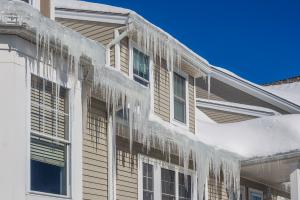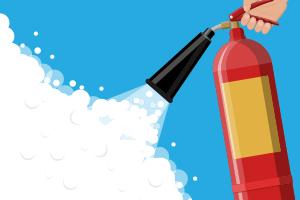Protect your property from severe winter weather
Every year, severe winter weather brings significant damage to buildings, in the form of frozen water pipes and roof collapses. Although you may have property insurance for your building, the payments you receive for your claim may not pay for all the damages sustained, and all the costs incurred, from a severe winter weather incident. The uninsured costs of the disruption to your business and the loss of clientele, for example, can easily exceed the costs to repair the building.
A few simple, short procedures can reduce the likelihood of a loss from winter weather, and are well worth the few minutes they would take, to complete. The following checklist is for your use in preventing what could become a disaster for your business.
Don't let your business become a statistic to winter weather.
Cold air in enclosed spaces
- Make a visual check in concealed spaces, such as above suspended ceilings and in closets/storage rooms, against exterior walls. Seal any gaps in wall materials, and provide insulation, if none is present. Water pipes in these areas will freeze, if not protected.
- If these spaces are unheated, make arrangements for heat to be provided (at least 50° F), or provide heat tape that has been certified by Underwriters Laboratories (UL), the Canadian Standards Association (CSA) or Factory Mutual Research Corporation (FMRC).
Sprinkler systems and related equipment
- Keep building temperatures above 50°F for wet-pipe systems.
- Anti-freeze systems should be checked, for adequate temperature ratings.
- Dry-pipe systems have water in them, up till the main valve, and these must be in a heated enclosure.
- Dry-pipe systems, with air in the piping, will still have condensation in them, and these must be drained, at the low points, by a servicing company.
- If there is a fire pump, the room this is in must be heated to at least 50°F.
- Hydrants, tanks, fire department connections and other sprinkler system accessories and parts should, along with the rest of the sprinkler system, receive service and inspection, before the onset of cold weather, with leaks repaired and protection provided.
General building protection
- If the building is to be unoccupied (e.g., over a vacation period, or over a weekend) when cold weather is present, inspections should be made, to be sure heating systems are functioning properly.
- Sources of cold air infiltration should be identified, and leaks or poor seals in doors or windows should be repaired.
- Roofs should be inspected, to assure they can withstand snow loads. Following a heavy snow, snow should be manually removed from roofs, if the roof strength is in question.
- Gutters, downspouts and roof drains should be kept clear, to avoid clogging and freezing.
- An emergency response plan should be made, for winter weather situations (e.g., loss of heat). This plan should include:
- Draining of any equipment which contains water, which could freeze.
- Sources of temporary heat, for a possible heating system failure.
- Training of security or maintenance/facility personnel, in how to close the automatic sprinkler valves, if a leak or break should occur
This material is provided for informational purposes only and does not provide any coverage or guarantee loss prevention. The examples in this material are provided as hypothetical and for illustration purposes only. The Hanover Insurance Company and its affiliates and subsidiaries (“The Hanover”) specifically disclaim any warranty or representation that acceptance of any recommendations contained herein will make any premises, or operation safe or in compliance with any law or regulation. By providing this information to you. The Hanover does not assume (and specifically disclaims) any duty, undertaking or responsibility to you. The decision to accept or implement any recommendation(s) or advice contained in this material must be made by you.
LC DEC 2018 12-198
171-1077 (01/14)
Related resources
Protect your property from severe winter weather
Every year, severe winter weather brings significant damage to buildings, in the form of frozen water pipes and roof collapses. Although you may have property insurance for your building, the payments you receive for your claim may not pay for all the damages sustained, and all the costs incurred, from a severe winter weather incident. The uninsured costs of the disruption to your business and the loss of clientele, for example, can easily exceed the costs to repair the building.
A few simple, short procedures can reduce the likelihood of a loss from winter weather, and are well worth the few minutes they would take, to complete. The following checklist is for your use in preventing what could become a disaster for your business.
Don't let your business become a statistic to winter weather.
Cold air in enclosed spaces
- Make a visual check in concealed spaces, such as above suspended ceilings and in closets/storage rooms, against exterior walls. Seal any gaps in wall materials, and provide insulation, if none is present. Water pipes in these areas will freeze, if not protected.
- If these spaces are unheated, make arrangements for heat to be provided (at least 50° F), or provide heat tape that has been certified by Underwriters Laboratories (UL), the Canadian Standards Association (CSA) or Factory Mutual Research Corporation (FMRC).
Sprinkler systems and related equipment
- Keep building temperatures above 50°F for wet-pipe systems.
- Anti-freeze systems should be checked, for adequate temperature ratings.
- Dry-pipe systems have water in them, up till the main valve, and these must be in a heated enclosure.
- Dry-pipe systems, with air in the piping, will still have condensation in them, and these must be drained, at the low points, by a servicing company.
- If there is a fire pump, the room this is in must be heated to at least 50°F.
- Hydrants, tanks, fire department connections and other sprinkler system accessories and parts should, along with the rest of the sprinkler system, receive service and inspection, before the onset of cold weather, with leaks repaired and protection provided.
General building protection
- If the building is to be unoccupied (e.g., over a vacation period, or over a weekend) when cold weather is present, inspections should be made, to be sure heating systems are functioning properly.
- Sources of cold air infiltration should be identified, and leaks or poor seals in doors or windows should be repaired.
- Roofs should be inspected, to assure they can withstand snow loads. Following a heavy snow, snow should be manually removed from roofs, if the roof strength is in question.
- Gutters, downspouts and roof drains should be kept clear, to avoid clogging and freezing.
- An emergency response plan should be made, for winter weather situations (e.g., loss of heat). This plan should include:
- Draining of any equipment which contains water, which could freeze.
- Sources of temporary heat, for a possible heating system failure.
- Training of security or maintenance/facility personnel, in how to close the automatic sprinkler valves, if a leak or break should occur
This material is provided for informational purposes only and does not provide any coverage or guarantee loss prevention. The examples in this material are provided as hypothetical and for illustration purposes only. The Hanover Insurance Company and its affiliates and subsidiaries (“The Hanover”) specifically disclaim any warranty or representation that acceptance of any recommendations contained herein will make any premises, or operation safe or in compliance with any law or regulation. By providing this information to you. The Hanover does not assume (and specifically disclaims) any duty, undertaking or responsibility to you. The decision to accept or implement any recommendation(s) or advice contained in this material must be made by you.
LC DEC 2018 12-198
171-1077 (01/14)
Related resources
Protect your property from severe winter weather
Every year, severe winter weather brings significant damage to buildings, in the form of frozen water pipes and roof collapses. Although you may have property insurance for your building, the payments you receive for your claim may not pay for all the damages sustained, and all the costs incurred, from a severe winter weather incident. The uninsured costs of the disruption to your business and the loss of clientele, for example, can easily exceed the costs to repair the building.
A few simple, short procedures can reduce the likelihood of a loss from winter weather, and are well worth the few minutes they would take, to complete. The following checklist is for your use in preventing what could become a disaster for your business.
Don't let your business become a statistic to winter weather.
Cold air in enclosed spaces
- Make a visual check in concealed spaces, such as above suspended ceilings and in closets/storage rooms, against exterior walls. Seal any gaps in wall materials, and provide insulation, if none is present. Water pipes in these areas will freeze, if not protected.
- If these spaces are unheated, make arrangements for heat to be provided (at least 50° F), or provide heat tape that has been certified by Underwriters Laboratories (UL), the Canadian Standards Association (CSA) or Factory Mutual Research Corporation (FMRC).
Sprinkler systems and related equipment
- Keep building temperatures above 50°F for wet-pipe systems.
- Anti-freeze systems should be checked, for adequate temperature ratings.
- Dry-pipe systems have water in them, up till the main valve, and these must be in a heated enclosure.
- Dry-pipe systems, with air in the piping, will still have condensation in them, and these must be drained, at the low points, by a servicing company.
- If there is a fire pump, the room this is in must be heated to at least 50°F.
- Hydrants, tanks, fire department connections and other sprinkler system accessories and parts should, along with the rest of the sprinkler system, receive service and inspection, before the onset of cold weather, with leaks repaired and protection provided.
General building protection
- If the building is to be unoccupied (e.g., over a vacation period, or over a weekend) when cold weather is present, inspections should be made, to be sure heating systems are functioning properly.
- Sources of cold air infiltration should be identified, and leaks or poor seals in doors or windows should be repaired.
- Roofs should be inspected, to assure they can withstand snow loads. Following a heavy snow, snow should be manually removed from roofs, if the roof strength is in question.
- Gutters, downspouts and roof drains should be kept clear, to avoid clogging and freezing.
- An emergency response plan should be made, for winter weather situations (e.g., loss of heat). This plan should include:
- Draining of any equipment which contains water, which could freeze.
- Sources of temporary heat, for a possible heating system failure.
- Training of security or maintenance/facility personnel, in how to close the automatic sprinkler valves, if a leak or break should occur
This material is provided for informational purposes only and does not provide any coverage or guarantee loss prevention. The examples in this material are provided as hypothetical and for illustration purposes only. The Hanover Insurance Company and its affiliates and subsidiaries (“The Hanover”) specifically disclaim any warranty or representation that acceptance of any recommendations contained herein will make any premises, or operation safe or in compliance with any law or regulation. By providing this information to you. The Hanover does not assume (and specifically disclaims) any duty, undertaking or responsibility to you. The decision to accept or implement any recommendation(s) or advice contained in this material must be made by you.
LC DEC 2018 12-198
171-1077 (01/14)
Related resources
Protect your property from severe winter weather
Every year, severe winter weather brings significant damage to buildings, in the form of frozen water pipes and roof collapses. Although you may have property insurance for your building, the payments you receive for your claim may not pay for all the damages sustained, and all the costs incurred, from a severe winter weather incident. The uninsured costs of the disruption to your business and the loss of clientele, for example, can easily exceed the costs to repair the building.
A few simple, short procedures can reduce the likelihood of a loss from winter weather, and are well worth the few minutes they would take, to complete. The following checklist is for your use in preventing what could become a disaster for your business.
Don't let your business become a statistic to winter weather.
Cold air in enclosed spaces
- Make a visual check in concealed spaces, such as above suspended ceilings and in closets/storage rooms, against exterior walls. Seal any gaps in wall materials, and provide insulation, if none is present. Water pipes in these areas will freeze, if not protected.
- If these spaces are unheated, make arrangements for heat to be provided (at least 50° F), or provide heat tape that has been certified by Underwriters Laboratories (UL), the Canadian Standards Association (CSA) or Factory Mutual Research Corporation (FMRC).
Sprinkler systems and related equipment
- Keep building temperatures above 50°F for wet-pipe systems.
- Anti-freeze systems should be checked, for adequate temperature ratings.
- Dry-pipe systems have water in them, up till the main valve, and these must be in a heated enclosure.
- Dry-pipe systems, with air in the piping, will still have condensation in them, and these must be drained, at the low points, by a servicing company.
- If there is a fire pump, the room this is in must be heated to at least 50°F.
- Hydrants, tanks, fire department connections and other sprinkler system accessories and parts should, along with the rest of the sprinkler system, receive service and inspection, before the onset of cold weather, with leaks repaired and protection provided.
General building protection
- If the building is to be unoccupied (e.g., over a vacation period, or over a weekend) when cold weather is present, inspections should be made, to be sure heating systems are functioning properly.
- Sources of cold air infiltration should be identified, and leaks or poor seals in doors or windows should be repaired.
- Roofs should be inspected, to assure they can withstand snow loads. Following a heavy snow, snow should be manually removed from roofs, if the roof strength is in question.
- Gutters, downspouts and roof drains should be kept clear, to avoid clogging and freezing.
- An emergency response plan should be made, for winter weather situations (e.g., loss of heat). This plan should include:
- Draining of any equipment which contains water, which could freeze.
- Sources of temporary heat, for a possible heating system failure.
- Training of security or maintenance/facility personnel, in how to close the automatic sprinkler valves, if a leak or break should occur
This material is provided for informational purposes only and does not provide any coverage or guarantee loss prevention. The examples in this material are provided as hypothetical and for illustration purposes only. The Hanover Insurance Company and its affiliates and subsidiaries (“The Hanover”) specifically disclaim any warranty or representation that acceptance of any recommendations contained herein will make any premises, or operation safe or in compliance with any law or regulation. By providing this information to you. The Hanover does not assume (and specifically disclaims) any duty, undertaking or responsibility to you. The decision to accept or implement any recommendation(s) or advice contained in this material must be made by you.
LC DEC 2018 12-198
171-1077 (01/14)





